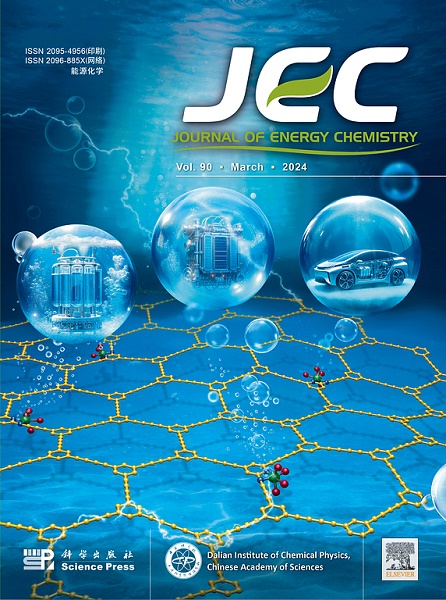Spin and orbital manipulation of multiple atomic sites by high-entropy effect for catalyzing cascade sulfur conversion
IF 13.1
1区 化学
Q1 Energy
引用次数: 0
Abstract
Lithium-sulfur (Li-S) batteries are considered a potential candidate for next-generation energy-dense and sustainable energy storage. However, the slow conversion and severe shuttle of polysulfides (LiPSs) result in rapid performance degradation over long-term cycling. Herein, we report a high-entropy single-atom (HE-SA) catalyst to regulate the multi-step conversion of LiPS to attain a high-performance Li-S battery. Both the density functional theory calculations and the experimental results prove that the Fe atomic site with high spin configurations strongly interacts with Li2S4 through d-p and s-p synergistic orbital hybridization which facilitates the reduction of LiPS. Moreover, S-dominant p-d hybridization between Li2S and a high-spin Mn site weakens the Li–S bond and facilitates the rapid sulfur evolution reaction. Consequently, the Li-S battery with a bifunctional HE-SA catalyst shows an ultralow capacity decay of 0.026 % per cycle over 1900 cycles at 1 C. This work proposes a high-entropy strategy for sculpting electronic structures to enable spin and orbital hybridization modulation in advanced catalysts toward long-cycling Li-S batteries.

利用高熵效应对多原子位的自旋和轨道操纵催化级联硫转化
锂硫(li -硫)电池被认为是下一代能量密集和可持续能源存储的潜在候选者。然而,在长期循环过程中,多硫化物(LiPSs)的缓慢转化和剧烈穿梭导致了性能的快速下降。在此,我们报道了一种高熵单原子(HE-SA)催化剂,用于调节LiPS的多步转化,以获得高性能Li-S电池。密度泛函数理论计算和实验结果都证明了具有高自旋构型的Fe原子位点通过d-p和s-p协同轨道杂化与Li2S4发生强相互作用,有利于lip的还原。此外,Li2S与高自旋Mn位点之间的s主导p-d杂化削弱了Li-S键,促进了硫的快速析出反应。因此,使用双功能HE-SA催化剂的Li-S电池在1℃下每循环1900次,其容量衰减率为0.026%。这项工作提出了一种高熵策略,用于塑造电子结构,以实现自旋和轨道杂化调制的高级催化剂,以实现长循环Li-S电池。
本文章由计算机程序翻译,如有差异,请以英文原文为准。
求助全文
约1分钟内获得全文
求助全文
来源期刊

Journal of Energy Chemistry
CHEMISTRY, APPLIED-CHEMISTRY, PHYSICAL
CiteScore
19.10
自引率
8.40%
发文量
3631
审稿时长
15 days
期刊介绍:
The Journal of Energy Chemistry, the official publication of Science Press and the Dalian Institute of Chemical Physics, Chinese Academy of Sciences, serves as a platform for reporting creative research and innovative applications in energy chemistry. It mainly reports on creative researches and innovative applications of chemical conversions of fossil energy, carbon dioxide, electrochemical energy and hydrogen energy, as well as the conversions of biomass and solar energy related with chemical issues to promote academic exchanges in the field of energy chemistry and to accelerate the exploration, research and development of energy science and technologies.
This journal focuses on original research papers covering various topics within energy chemistry worldwide, including:
Optimized utilization of fossil energy
Hydrogen energy
Conversion and storage of electrochemical energy
Capture, storage, and chemical conversion of carbon dioxide
Materials and nanotechnologies for energy conversion and storage
Chemistry in biomass conversion
Chemistry in the utilization of solar energy
 求助内容:
求助内容: 应助结果提醒方式:
应助结果提醒方式:


